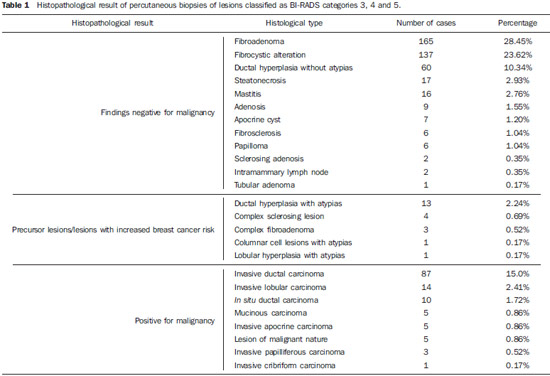Radiologia Brasileira - Publicação Científica Oficial do Colégio Brasileiro de Radiologia
AMB - Associação Médica Brasileira CNA - Comissão Nacional de Acreditação
 Vol. 46 nº 4 - July / Aug. of 2013
Vol. 46 nº 4 - July / Aug. of 2013
|
ORIGINAL ARTICLE
|
|
Positive predictive values of Breast Imaging Reporting and Data System (BI-RADS®) categories 3, 4 and 5 in breast lesions submitted to percutaneous biopsy |
|
|
Autho(rs): Gustavo Machado Badan1; Décio Roveda Júnior2; Carlos Alberto Pecci Ferreira3; Felipe Augusto Trocoli Ferreira4; Eduardo de Faria Castro Fleury5; Mário Sérgio Dantas do Amaral Campos4; Rodrigo de Oliveira Seleti6; Hélio da Cruz Júnior7 |
|
|
Keywords: Breast cancer; BI-RADS; Percutaneous biopsy; Positive predictive value; Histological diagnosis. |
|
|
Abstract: INTRODUCTION
Breast cancer is the most frequent type of cancer in women worldwide, both in developed and developing countries. About 226,870 new cases are expected, and 39,510 women will die because of breast cancer in the United States of America in 2012(1). According to Instituto Nacional de Câncer (INCA) estimates of cancer incidence in Brazil this year, 52,680 new cases are expected, with an estimated risk of 52 cases in 100 thousand women(2). According to extensive observational series, the rate of breast cancer mortality has decreased to 31%, primarily due to the contribution of yearly mammographic screening programs which have lead to early detection of the disease in a considerable number of cases(3–5). The Colégio Brasileiro de Radiologia e Diagnóstico por Imagem (CBR) (Brazilian College of Radiology and Imaging Diagnosis) and the National Commission on Mammography recommend yearly mammographic screening for every women between 40 and 69 years, and on an individual basis after that age range(6). However, the mammographic screening has been followed by a high number of biopsies, although mammographic findings considered as suspicious for malignancy may correspond to benign alterations. Thus, despite the high mammographic sensitivity and specificity, the positive predictive value (PPV) of biopsies reveals malignancy in only 15% to 40% of cases(7,8). In order to reduce the disagreement in breast images interpretation, and to standardize reports and respective recommendations, in 1993, the American College of Radiology published the Breast Imaging Reporting and Data System (BI-RADS®)(9), which is currently in its fourth edition(10,11). The present study was aimed at evaluating the BI-RADS as a predictive factor for suspicion of malignancy in breast lesions by correlating radiological findings with histological results in a breast cancer reference hospital in São Paulo, SP. Brazil. Such a comparison was undertaken by means of PPV calculation for BI-RADS categories 3, 4 and 5 in order to improve the management of abnormal imaging findings. As a secondary objective, the authors have determined the PPV of morphological characteristics of the breast lesions most frequently associated with malignancy. MATERIALS AND METHODS By means of a retrospective, analytical and cross sectional study approved by the Committee for Ethics in Research of the Institution, and developed in the Breast Imaging Service at Santa Casa de Misericórdia de São Paulo, the authors evaluated histological results of 725 patients with mean age of 49 years (age range = 16 to 84 years). Such patients presented palpable or non palpable breast lesions at mammography and/or ultrasonography, classified as BIRADS categories 3, 4 and 5, and were referred for fine needle aspiration biopsy (FNAB), core biopsy or vacuum-assisted core biopsy in the period from February 1st, 2011 to July 31, 2012. The patients had their results reviewed on the day of the procedure, and the findings were reclassified according the BI-RADS categories by a clinical team with more than ten-year experience in breast imaging. The cases reclassification was based on a review of the mammographic images and in cases of ultrasonography-guided biopsy a new sonographic study was performed. Finally, the BI-RADS lexicon for breast lesions was utilized, and then the final categorization was done. Microcalcifications were assessed according their morphology (punctiform, pleomorphic or fine pleomorphic and liner-branching), and according their distribution (clustered or segmental). Nodules were classified according their shape (ovoid, round or irregular) and margins (circumscribed, non circumscribed and spiculated). Among lesions with non circumscribed margins, the lesions with spiculated margins were separately evaluated considering their high association with malignancy. Also, focal asymmetry, with or without associated findings (microcalcifications or distortion), and architectural distortion were evaluated. In the present study, the exclusion criteria were the following: a) radiological findings classified as BI-RADS 2; b) cases considered unsatisfactory for purposes of cytological analysis. Core biopsies were performed with 12-gauge needles, collecting eight samples per procedure, and the vacuum-assisted biopsies (Surus system), with 9-gauge needles, both under digital stereotactic guidance (Lorad Multicare Platinum; Hologic). As regards ultrasonography-guided core biopsy (EnVisor Ultrasound System; Philips Healthcare), 14-gauge needles were utilized, collecting four samples per procedure. Ultrasonography was the method of choice for guidance in FNAB. In all the cases of biopsied microcalcifications, the specimens were submitted to radiography and considered satisfactory as calcifications were detected. The PPVs were calculated and final results were compared with those in the literature. RESULTS Among the 725 lesions submitted to percutaneous biopsy, 133 were excluded for being reclassified as BI-RADS 2, and other 12 cases with unsatisfactory material were eliminated. So, 580 procedures met all the inclusion criteria. In this total of cases, the percentage distribution of imaging studies according their BI-RADS classification showed 47.58% (276) for category 3, 39.65% (230) for category 4, and 12.75% (74) for category 5. Most of the interventional procedures, represented by 64.82% (376) of cases, was performed by means of core biopsy, and 35.18% (204) by FNAB. The histological results demonstrated 77.59% negative for malignancy, and 22.41% positive for malignancy (Table 1). Among the results negative for malignancy (450 cases), the most prevalent were fibroadenomas (36.66%) and fibrocystic alterations (30.44%), while results positive for malignancy (130 cases) were represented by invasive ductal carcinoma (67%), followed by invasive lobular carcinoma (10.7%) and by in situ ductal carcinoma (7.7%). The data indicate a predominance of benign results in patients classified as BI-RADS 3, both at mammography (100.00%) and at ultrasonography (99.26%). The PPV of BI-RADS category 4 was 14.90% for the cases of stereotactic biopsy, and 33.08% for cases of ultrasonography-guided biopsy. For BI-RADS category 5, the authors obtained PPV of 100.00% at mammography and 92.25% at ultrasonography (Tables 2 and 3). 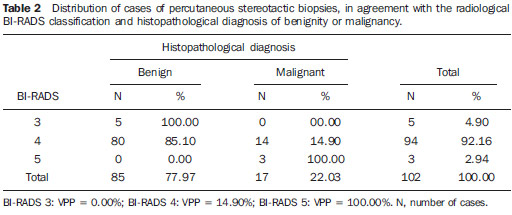 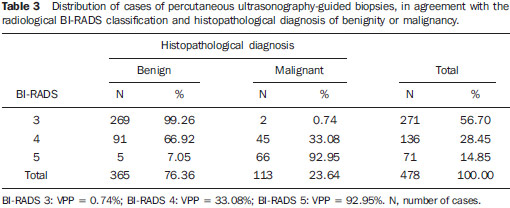 One of the two cases classified as BI-RADS 3 and positive for neoplastic cells is represented on Figure 1. And among the five cases classified as BI-RADS 5 with histological results negative for malignancy, one is shown on Figure 2. 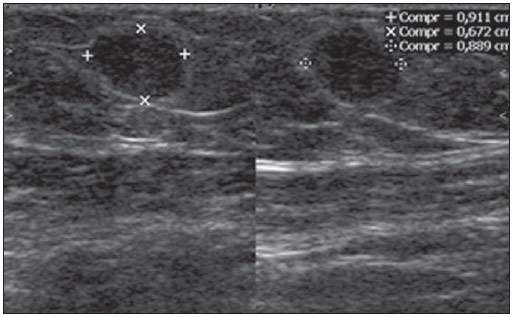 Figure 1. Non palpable nodules located in the axillary extension of the left breast in a 63-year-old woman. Ultrasonography demonstrates an ovoid, hypoechoic, circumscribed nodule measuring 9 × 6 × 8 mm, with homogeneous echotexture, parallel orientation, without posterior acoustic shadowing. Category BIRADS 3. FNAB demonstrated the presence of cells positive for malignancy. Surgery revealed a mucinous carcinoma measuring 7 mm with negative sentinel lymph node. 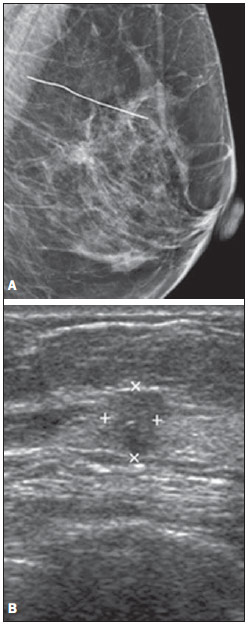 Figure 2. Non palpable nodule in the retroareolar region of the left breast in a 66-year-old woman previously submitted to surgery for a benign nodule in the same breast. A: Mammography demonstrates the presence of an irregular, isodense nodule with spiculated margins. Category BI-RADS 5. B: Ultrasonography demonstrates irregular, hypoechoic nodule with angulated margins, measuring 6 mm, with heterogeneous echotexture, non parallel orientation, and posterior acoustic shadowing. Category BI-RADS 5. Core biopsy revealed adenosis and fibrocystic alterations. Considering the absence of anatomo-radiological correlation, the patient underwent surgery that revealed the same anatomopathological finding. In general, the morphological criteria of lesions most related to malignancy were fine pleomorphic and linear branching microcalcifications (100%) and irregular nodules with spiculated margins (92.25%) (Tables 4 and 5). 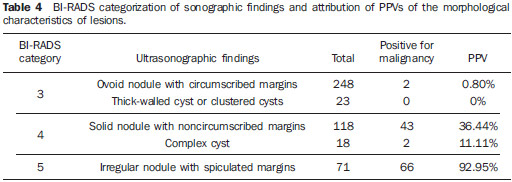 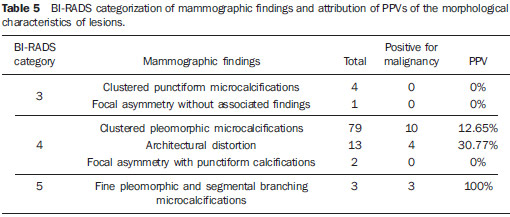 DISCUSSION Since 1993, when the BI-RADS was published, innumerable studies have been developed to correlate imaging findings with histopathological results(9). Although the BI-RADS itself recommends that biopsy is not performed in patients with lesions classified as BI-RADS category 3, such a procedure is performed in a high number of cases. The main reasons for the practice of biopsy include patients' anxiety, physicians' insecurity and presence of risk factors for breast cancer. With the objective of providing mastologists with further information to select patients eligible for biopsy, studies in the literature have tried to establish the PPVs of BI-RADS categories 3, 4 and 5(12). Studies in the literature have reported PPV for category 3 between 0% e 3%, while for category 4it has ranged between 15% and 40%, and for category 5, between 81% and 97%(7,8,12–17). As the present study results are correlated with those in the literature, one observes that in spite being within the expected ranges for their respective categories, particularly in category 3, the PPVs approximated the inferior threshold (PPV of 0.0% for mammography and 0.74% for ultrasonography), while in category 5 PPV of 92.95% was observed in cases of ultrasonography-guided biopsies, approximating the superior threshold reported by the studies and 100% for stereotactic biopsies, which demonstrates a good accuracy of the team in the BI-RADS categorization. The categorization according the BI-RADS may present limitations due to deficient training of radiologists, influencing PPV results(18,19). For this reason, all the cases were reclassified by a highly experienced team specialized in breast radiology before undergoing biopsy. The authors attribute the present results to the study method which previously to the procedure reclassified the breast lesions. In the present study, the PPV for BIRADS category 4 was 33.08% in the cases with ultrasonography-guided biopsy, within the expected average reported in the literature; and 14.9% in the cases with stereotactic biopsy, an index similar to the values found by Melhado et al.(17). Histopathological analyses of breast biopsies of women whose mammograms revealed suspicious microcalcifications diagnosed breast cancer in 10% to 40% of cases(20). In the present study, among 82 biopsied cases (BI-RADS 4 and 5), 13 were malignant lesions, revealing PPV of 15.85%. Pleomorphic and linear branching lesions, particularly those with segmental distribution, are considered as highly suspicious(21,22) and, according to Liberman et al., reveal malignancy in 81% to 92% of cases(14). In the present study, three cases presented such characteristics, and all of them were positive for malignancy. In several studies in the literature, morphological criteria with higher PPV in relation to nodules were spiculated margins, followed by irregular shape ranging from 70% to 92%(14,23–26). For irregular and spiculated nodules, the authors have found PPV of 94.28%, a value similar to those reported in the literature. On the other hand, reports in the literature indicate that a nodule with circumscribed margin is the criterion that is most frequently associated with benignity, in agreement with the present study results (99.1% of benign cases)(23,27–29). CONCLUSION The present study has demonstrated agreement with data in the literature regarding the prediction of a benign or malignant nature of breast lesions, with the objective of improving the appropriate management of lesions while optimizing the practice of biopsies. Among the morphological criteria, spiculated margins of nodules and segmental, fine pleomorphic and branching microcalcifications are most frequently associated with malignancy. Considering the present study results, one can affirm with certainty that lesions classified as BI-RADS category 5 are highly suspicious of malignancy, and that the major contribution is related to a conservative management of breast lesions classified as mammographic and/or sonographic BI-RADS category 3, in order to avoid unnecessary biopsies. As regards BI-RADS category 4, the authors have found out the necessity of systematic biopsies. REFERENCES 1. National Cancer Institute. Surveillance, Epidemiology and End Results (SEER). [acessado em 13 de agosto de 2012]. Disponível em: http://seer.cancer.gov. 2. Ministério da Saúde. Instituto Nacional de Câncer. Estimativa 2012: incidência de câncer no Brasil. [acessado em 16 de agosto de 2012]. Disponível em: http://www.inca.gov.br/estimativa/2012. 3. Tabár L, Vitak B, Chen TH, et al. Swedish two-county trial: impact of mammographic screening on breast cancer mortality during 3 decades. Radiology. 2011;260:658–63. 4. Kopans DB, Smith RA, Duffy SW. Mammographic screening and "overdiagnosis". Radiology. 2011;260:616–20. 5. Miranda CMNR, Santos CJJ, Maranhão CPM, et al. A tomografia computadorizada multislice é ferramenta importante para o estadiamento e seguimento do câncer de mama? Radiol Bras. 2012;45:105–12. 6. Urban LABD, Schaefer MB, Duarte DL, et al. Recomendações do Colégio Brasileiro de Radiologia e Diagnóstico por Imagem, da Sociedade Brasileira de Mastologia e da Federação Brasileira das Associações de Ginecologia e Obstetrícia para rastreamento do câncer de mama por métodos de imagem. Radiol Bras. 2012;45:334–9. 7. Kestelman FP, Souza GA, Thuler LC, et al. Breast Imaging Reporting and Data System – BI-RADS®: valor preditivo positivo das categorias 3, 4 e 5. Revisão sistemática da literatura. Radiol Bras. 2007;40:173–7. 8. Hall FM, Storella JM, Siverstone DZ, et al. Non-palpable breast lesions: recommendations for biopsy based on suspicion of carcinoma at mammography. Radiology. 1988;167:353–8. 9. American College of Radiology. Breast Imaging Reporting and Data System (BI-RADS). Reston, VA: American College of Radiology; 1993. 10. American College of Radiology. The ACR Breast Imaging Reporting and Data System (BI-RADS®). 4th ed. Reston, VA: American College of Radiology; 2003. 11. Chala LF, Barros N. ACR BI-RADS na ultra-sonografia. Radiol Bras. 2004;37(2):iii–iv. 12. Roveda Jr D, Piato S, Oliveira VM, et al. Valores preditivos das categorias 3, 4 e 5 do sistema BIRADS em lesões mamárias nodulares não palpáveis avaliadas por mamografia, ultra-sonografia e ressonância magnética. Radiol Bras. 2007;40:93–8. 13. Raza S, Chikarmane SA, Neilsen SS, et al. BIRADS 3, 4, and 5 lesions: value of US in management – follow-up and outcome. Radiology. 2008;248:773–81. 14. Liberman L, Abramson AF, Squires FB, et al. The Breast Imaging Reporting and Data System: positive predictive value of mammographic features and final assessment categories. AJR Am J Roentgenol. 1998;171:35–40. 15. Lacquement MA, Mitchell D, Hollingsworth AB. Positive predictive value of the Breast Imaging Reporting and Data System. J Am Coll Surg. 1999;189:34–40. 16. Orel SG, Kay N, Reynolds C, et al. BI-RADS categorization as a predictor of malignancy. Radiology. 1999;211:845–50. 17. Melhado CV, Alvares RB, Almeida JO. Correlação radiológica e histológica de lesões mamárias não palpáveis em pacientes submetidas a marcação pré-cirúrgica, utilizando-se o sistema BIRADS. Radiol Bras. 2007;40:9–11. 18. Liberman L, Menell JH. Breast Imaging Reporting and Data System (BI-RADS). Radiol Clin North Am. 2002;40:409–30. 19. Godinho ER, Koch HA. Breast Imaging Reporting and Data System (BI-RADS): como tem sido utilizado? Radiol Bras. 2004;37:413–7. 20. Coşar ZS, Çetin M, Tepe TK, et al. Concordance of mammographic classifications of microcalcifications in breast cancer diagnosis: utility of the Breast Imaging Reporting and Data System (fourth edition). Clin Imaging. 2005;29:389–95. 21. Burnside ES, Ochsner JE, Fowler KJ, et al. Use of microcalcification descriptors in BI-RADS 4th edition to stratify risk of malignancy. Radiology. 2007;242:388–95. 22. Nascimento JHR, Silva VD, Maciel AC. Acurácia dos achados mamográficos do câncer de mama: correlação da classificação BI-RADS e achados histológicos. Radiol Bras. 2010;43:91–6. 23. Calas MJG, Koch HA, Dutra MVP. Ultrassonografia mamária: avaliação dos critérios ecográficos na diferenciação das lesões mamárias. Radiol Bras. 2007;40:1–7. 24. Bérubé M, Curpen B, Ugolini P, et al. Level of suspicion of a mammographic lesion: use of features defined by BI-RADS lexicon and correlation with large-core breast biopsy. Can Assoc Radiol J. 1998;49:223–8. 25. Mendez A, Cabanillas F, Echenique M, et al. Mammographic features and correlation with biopsy findings using 11-gauge stereotactic vacuum-assisted breast biopsy (SVABB). Ann Oncol. 2004;15:450–4. 26. Stavros AT, Thickman D, Rapp CL, et al. Solid breast nodules: use of sonography to distinguish between benign and malignant lesions. Radiology. 1995;196:123–34. 27. Zonderland HM, Hermans J, Coerkamp EG. Ultrasound variables and their prognostic value in a population of 1103 patients with 272 breast cancers. Eur Radiol. 2000;10:1562–8. 28. Murad M, Bari V. Ultrasound differentiation of benign versus malignant solid breast masses. J Coll Physicians Surg Pak. 2004;14:166–9. 29. Calas MJG, Alvarenga AV, Gutfilen B, et al. Avaliação de parâmetros morfométricos calculados a partir do contorno de lesões de mama em ultrassonografias na distinção das categorias do sistema BI-RADS. Radiol Bras. 2011;44:289–96. 1. Specialist in Breast Imaging, Second Radiologist Assistant, Breast Radiology Group of Santa Casa de Misericórdia de São Paulo, São Paulo, SP, Brazil 2. PhD, Professor of Radiology, Director of the Department of Imaging Diagnosis, Santa Casa de Misericórdia de São Paulo, São Paulo, SP, Brazil 3. Physician Assistant, Coordinator, Breast Imaging Service, Department of Medical Practice, Faculdade de Medicina da Santa Casa de São Paulo, São Paulo, SP, Brazil 4. MDs, Specialists in Radiology, Second Radiologist Assistants, Santa Casa de Misericórdia de São Paulo, São Paulo, SP, Brazil 5. PhD, Professor of Radiology, Second Radiologist Assistant, Santa Casa de Misericórdia de São Paulo, São Paulo, SP, Brazil 6. MD, Specialist in Radiology, Fellow Master degree in Breast Imaging, Santa Casa de Misericórdia de São Paulo, São Paulo, SP, Brazil 7. Fellow Master degree in Breast Imaging, Santa Casa de Misericórdia de São Paulo, São Paulo, SP, Brazil Mailing Address: Dr. Gustavo Machado Badan Rua Loureiro da Cruz, 121, ap. 121, Aclimação São Paulo, SP, Brazil, 01529-020 E-mail: gustavobadan@hotmail.com Received November 26, 2012. Accepted after revision April 1st, 2013. * Study developed at Faculdade de Ciências Médicas da Santa Casa de São Paulo, São Paulo, SP, Brazil. |
|
Av. Paulista, 37 - 7° andar - Conj. 71 - CEP 01311-902 - São Paulo - SP - Brazil - Phone: (11) 3372-4544 - Fax: (11) 3372-4554
